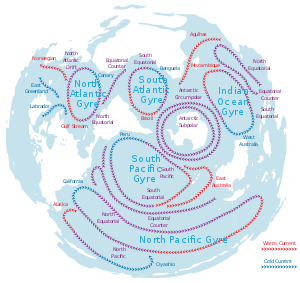Great Pacific garbage patch


The Great Pacific garbage patch , also described as the Pacific trash vortex , is a gyre of marine debris particles in the central North Pacific Ocean discovered between 1985 and 1988. It is located roughly between 135°W to 155°W and 35°N and 42°N . [1] The patch extends over an indeterminate area of widely varying range depending on the degree of plastic concentration used to define the affected area.
The patch is characterized by exceptionally high relative concentrations of pelagic plastics , chemical sludge and other debris that have been trapped by the currents of the North Pacific Gyre . [2]

It is thought that, like other areas of concentrated marine debris in the world's oceans, the Great Pacific garbage patch formed gradually as a result of ocean or marine pollution gathered by oceanic currents . [12] The garbage patch occupies a large and relatively stationary region of the North Pacific Ocean bound by the North Pacific Gyre (a remote area commonly referred to as the horse latitudes ). The gyre's rotational pattern draws in waste material from across the North Pacific Ocean, including coastal waters off North America and Japan. As material is captured in the currents, wind-driven surface currents gradually move floating debris toward the center, trapping it in the region.
Related: Scientists Discover Plastic-Eating Worm


The Great Pacific garbage patch has one of the highest levels known of plastic particulate suspended in the upper water column. As a result, it is one of several oceanic regions where researchers have studied the effects and impact of plastic photodegradation in the neustonic layer of water. [26] Unlike organic debris, which biodegrades , the photodegraded plastic disintegrates into ever smaller pieces while remaining a polymer . This process continues down to the molecular level . [27]
As the plastic flotsam photodegrades into smaller and smaller pieces, it concentrates in the upper water column. As it disintegrates, the plastic ultimately becomes small enough to be ingested by aquatic organisms that reside near the ocean's surface. In this way, plastic may become concentrated in neuston , thereby entering the food chain .
Some plastics decompose within a year of entering the water, leaching potentially toxic chemicals such as bisphenol A , PCBs , and derivatives of polystyrene . [28]
Effect on wildlife and humans
Some of these long-lasting plastics end up in the stomachs of marine animals, and their young, [5] [29] [30] including sea turtles and the black-footed albatross . Midway Atoll receives substantial amounts of marine debris from the patch. Of the 1.5 million Laysan albatrosses that inhabit Midway, nearly all are likely to have plastic in their digestive system . [31] Approximately one-third of their chicks die, and many of those deaths are due to being fed plastic from their parents. [32] [33] Twenty tons of plastic debris washes up on Midway every year with five tons of that debris being fed to albatross chicks. [34]
Humanity is destroying its habitat.
True.
And its much worse than most people realize.
The ability to avoid thinking or doing anything about the destruction we are reeking on the planet never ceases to amaze me.
All life comes for the earth, it's simply a commitment to slow suicide.